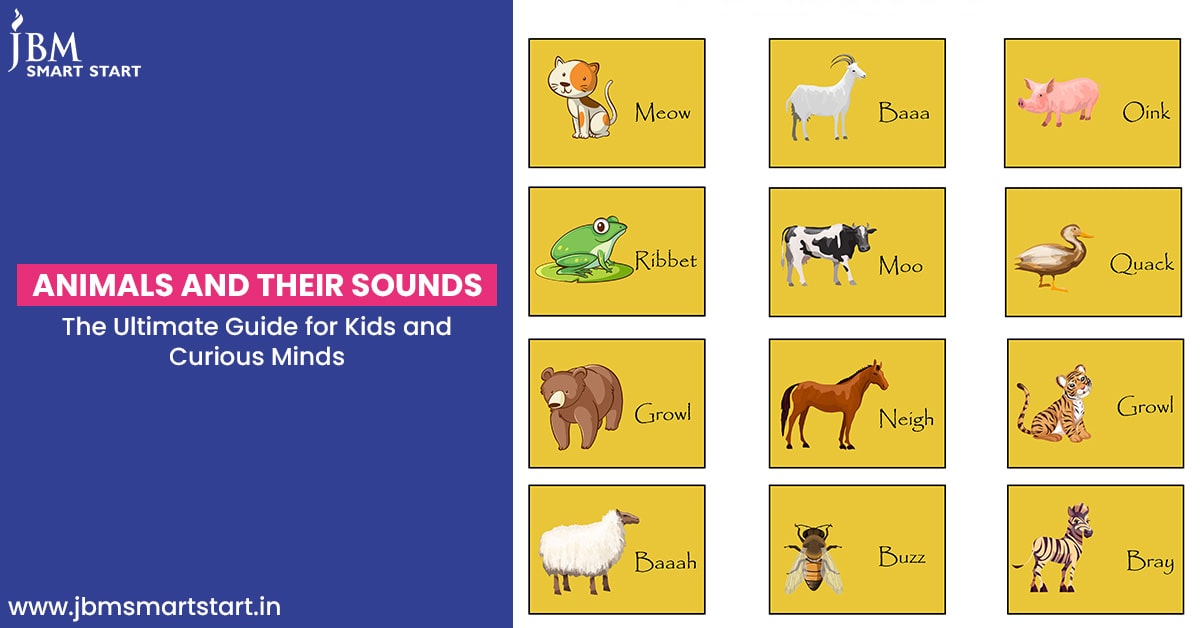
Types of Animals: Fun Classification Guide for Kids
April 24, 2025
30 Fun Summer Activities for Kids They’ll Love
May 25, 2025Animals and Their Sounds: The Ultimate Guide for Kids and Curious Minds
Discover the Fun World of Animals and Their Sounds
Is there anything more exciting than hearing a lion roar or a duck quack for the first time? This is where you can experience the magical world of animals and their sounds! The different animal sounds for kids not only make them more curious but also help them learn various skills.
When children learn animal sounds, it leads them to develop sharper memory, stronger speech skills, and a deeper connection with the natural world.
This blog explores the fascinating world of animals and their sounds! It includes lists of animal sounds in English and how you can help kids learn and remember them!
Let’s dive into this noisy and playful adventure together!
Why Learning Animals and Their Sounds Is Important for Kids
1: Boosts Early Speech Development
Kids are often found to mimic animal sounds. This, in a way, helps them to practice the basic building blocks of language that are vowels, consonants, rhythm, and tone.
If they start by saying “moo” or “baa,” it lays the foundation for forming full words later on!
2: Enhances Memory and Listening Skills
If your child can recognise and recall different animal sounds with names, it means that they have strong memory and auditory skills.
It also implies that they can easily associate a sound with an image.
3: Builds Emotional Bonds with Animals and Nature
Animal sounds for kids help them form emotional connections with living beings. If children can imitate a dog’s bark or a bird’s chirp, it allows them to understand and care about the natural world around them.
At JBM Smart Start School, the children go through holistic growth and personality development. This is why such activities are part of the engaging curriculum.
Don’t Miss This: List of Animals & Their Young Ones
Explore the World of Animals and Their Sounds
List of Common Animals and Their Sounds in English
These are the animals that kids are most likely to encounter in books, cartoons, or at home. Their animal sounds in English are fun to learn and mimic.
1: Dog – Barks
Dogs bark (“woof-woof”) when they are excited, protective, or playful. They are great companions for people of any age group.
They are the biggest examples of loyal and unconditional love.
2: Cat – Meows
A cat usually meows softly or loudly, depending on its mood. A soft meow can mean affection, and a loud one usually says, “Feed me now!”
3: Cow – Moos
A moo from a cow is used to communicate with other cows or call their calves.
4: Duck – Quacks
A quack from a duck is used to signal to its ducklings. You can also hear their quacking while they’re splashing around. It’s one of the funniest animal sounds for kids to imitate!
5: Horse – Neighs
You will usually find a horse neighing when they’re excited, or they may be calling out to other horses.
6: Sheep – Baaas
You’ll hear them especially when they’re calling for their lambs. There’s a popular children’s rhyme that uses this animal sound!
7: Pig – Oinks
A pig oinks when it’s excited or happy. It’s usually when they’re around food! This grunting sound can be extremely funny for kids to mimic.
8: Rooster – Crows
A rooster crows (“cock-a-doodle-doo”) loudly at dawn. This fun morning greeting sound is the perfect way to start the day!
9: Frog – Croaks
You’ll hear croaking frogs in the evenings, especially when it has been raining. So, look out for these little amphibians the next time it rains!
10: Bird – Chirps
A bird chirps and tweets. This can be soothing and musical and is often heard around trees or windows.
Love pets? Check This Out: Pet Animals Names in English with Pictures
Farm Animals and Their Sounds – A Noisy and Fun Learning Experience
Now it’s time for us to head to the farm! Be prepared because it’s quite loud in here because of all the farm animal sounds!
1: Chicken – Clucks
A chicken uses its call to signal its chicks or remind them to be alert.
2: Goat – Bleats
The bleating of a goat has a “maa” sound. It’s one of the silliest sounds, but it can be funny for kids.
3: Turkey – Gobbles
A turkey gobbles rapidly, especially while it’s feeding.
4: Donkey – Brays
You’ll hear a loud “hee-haw” from a donkey. It’s an exaggerated and comical sound that kids would love to act out.
5: Geese – Honk
They honk loudly, especially when they sense danger. This allows them to alert other geese around them.
6: Lamb – Bleats
A lamb bleats but more gently than a goat. It’s more like a soothing and sleepy sound.
7: Bull – Bellows
This is a deep and loud sound that is usually made to assert dominance.
8: Hen – Cackles
A hen usually cackles after laying eggs as if to make a proud announcement!
9: Rabbit – Thumps
A rabbit doesn’t usually make a sound. Instead, it thumps the ground with its foot.
10: Ox – Moos
It sounds similar to a cow but is way deeper!
Curious Where Animals Live? Animals and Their Homes: A Fun Learning Guide for Kids
Wild Animals and Their Sounds – A Jungle Adventure for Kids
Now, it’s time to step into the jungle! Adventure, excitement, and wild animal sounds await you!
1: Lion – Roars
A lion roars to show off their power or call their pride.
2: Elephant – Trumpets
This is a loud sound that is made with their trunks. It’s usually when they’re excited or alarmed. Kids can pretend their arms are trunks and mimic the trumpets of elephants!
3: Monkey – Chatters
Chatters and whoops are common monkey sounds! It’s usually because they’re playing or warning others.
4: Wolf – Howls
A wolf’s howling can be a sign of marking territory. However, they also use this call to find their pack.
5: Tiger – Growls
A tiger mostly growls when it’s threatened. It is usually a very low and rumbling sound.
6: Bear – Growls or Roars
A bear can growl or roar while trying to defend itself.
7: Hyena – Laughs
You must have heard your friends laugh. But, can you imagine an animal laughing? A hyena laughs, literally! Their cackling sound is unique and hilarious for kids.
8: Snake – Hisses
The hiss of a snake should be considered a warning.
9: Owl – Hoots
You’ll only hear the hooting of an owl at night. The classic “hoo-hoo” sound is quite eerie as well as exciting!
10: Zebra – Brays
The zebra brays almost like a donkey!
Discover More Creatures: Different Types of Animals: A Fun and Simple Guide for Kids
Funny and Unique Animal Sounds That Will Surprise You
Now it’s time to giggle and go “Wait, they sound like that?!”
1: Koala – Grunting & Snoring
These noises are usually made by the males. It’s unexpectedly loud!
2: Crocodile – Bellows
This is usually heard underwater during mating season. It’s deep and mysterious.
3: Giraffe – Hums
A giraffe hums at night to communicate within its herd. This has only recently been discovered by scientists!
4: Penguin – Squawks
They make these sounds to find their chicks in huge colonies. Each of their squawks is unique, like a fingerprint.
5: Peacock – Screeches
This is quite a dramatic sound, which is only made during mating season. It’s loud, proud, and unforgettable!
6: Dolphin – Clicks & Whistles
The purpose of these sounds is echolocation and communication.
Spark Their Curiosity: Fun Facts for Kindergartners: 30 Engaging and Exciting Facts to Spark Curiosity
How to Teach Animals and Their Sounds to Kids in Fun Ways
Here’s where the real fun begins: making animals and their sounds part of your child’s everyday adventures!
1: Read Storybooks with Sounds
You can choose animal-themed books that include sounds. Next, you should act out the animal sounds in English together! For example, when you read “The cow goes moo,” you should ask your child to do it too. When you add sound effects for more drama, it also adds fun.
2: Use Flashcards with Sound Effects
You can also create or buy flashcards with pictures and labels like “Lion – Roar”. This game includes flipping one and asking your child to name the animal and mimic the sound.
It helps them recognise and associate each animal with their respective sounds. It’s perfect for learning animal sounds through repetition.
3: Play Sound and Picture Matching Games
You can play a game where kids listen to a sound (from a phone or tablet) and match it to the correct animal card. This sharpens their hearing and memory skills!
4: Watch Interactive YouTube Videos or Use Educational Apps
There are amazing videos and apps designed to teach animal sounds for kids with the help of songs and cartoons.
They combine visual, auditory, and movement learning. They should try dancing to “Old MacDonald Had a Farm” with real animal clips!
5: DIY Animal Sound Guessing Game
You can also record different animal sounds and play them one by one. You must ask them: “What animal makes this sound?”
You can even blindfold them for extra giggles. It’s simple, exciting, and totally screen-free!
At JBM Smart Start School, such activities are key to the early learning model for kids. It’s firmly believed that education should be hands-on, joyful, and full of laughter!
Keep Little Ones Engaged: Activities for Nursery Class Students: Fun and Educational Ideas for Kids
Final Thoughts: Why Animal Sounds Matter in Early Learning
Thus, animals and their sounds open a joyful and educational world for kids. These early experiences shape speech, memory, and a love for animals.
This is why you must encourage your child to learn animal sounds in creative ways every day!
At JBM Smart Start School, one of the best preschools in Noida, we make learning fun, engaging, and meaningful. Enrol your child for the 2025–26 session and give them the smart start they deserve!
Also Read: Why Birds & Animals Are Important For Our Planet?
FAQs About Animal Sounds and Early Childhood Learning
Q1: What are the most common animal sounds kids should learn first?
Ans: Kids should start with easy, recognisable sounds like a dog barking, a cow mooing, and a duck quacking. These help them quickly connect sounds to familiar animals.
Q2: Why is it important for children to learn animal sounds?
Ans: Learning animal sounds for kids boosts language development, improves memory, and nurtures a bond with nature, making early education fun and effective.
Q3: How can I teach my child animal sounds in a fun way?
Ans: You can use storybooks, matching games, and apps where kids learn animal sounds interactively, turning playtime into an exciting learning experience.
Q4: Do all animals make unique sounds, and what do they mean?
Ans: Yes, every animal has a unique sound serving different purposes, like attracting mates, signalling danger, or communicating socially.
Q5: Which animal has the highest voice?
Ans: Bats hold the record for the highest-pitched sounds! Their echolocation clicks are so high that humans can’t hear them without special equipment.




